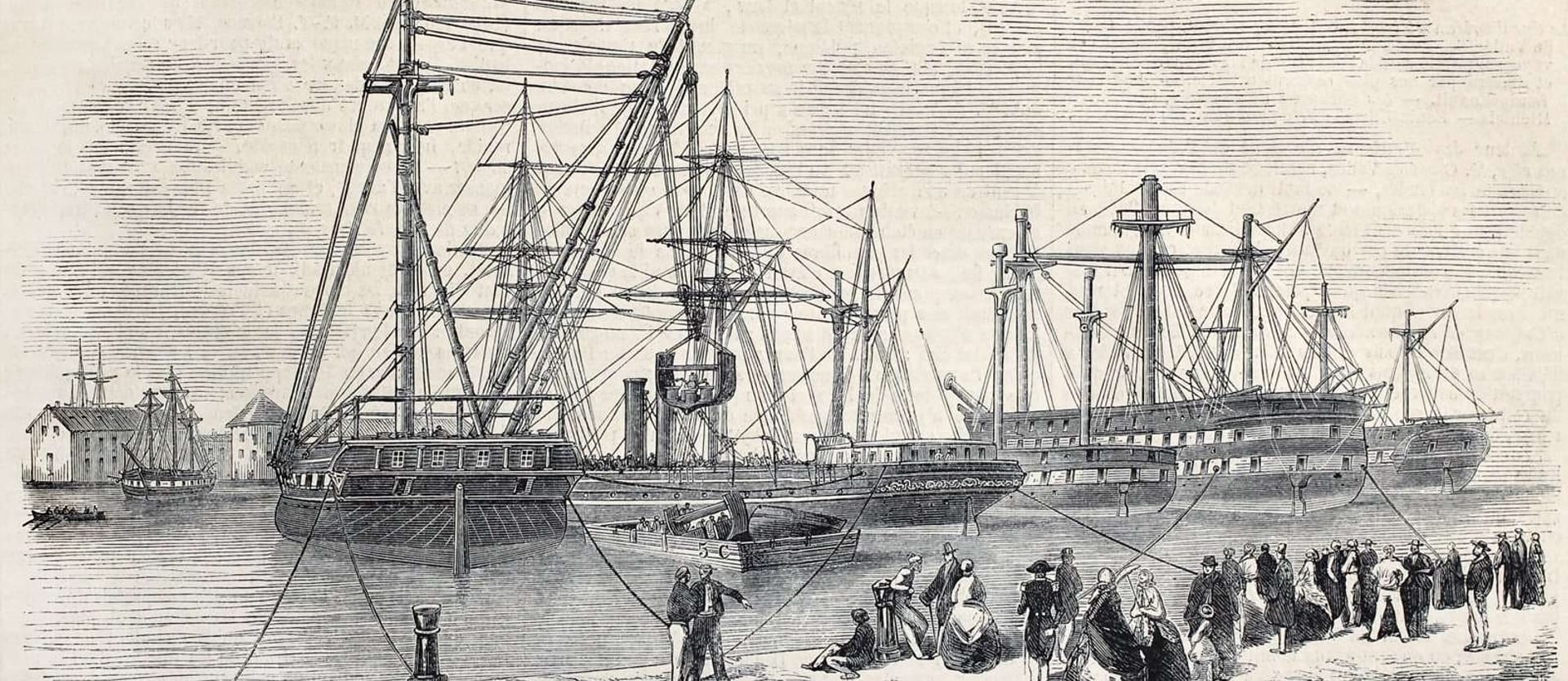Perhaps the oldest existing bill of lading, found at a garage sale in the 50s and brought to the National Maritime Museum in Greenwich in the 80s, this document describes an agreement to deliver 100 bales of silks from Turkish Smyrna (now Izmir) to London in 1675.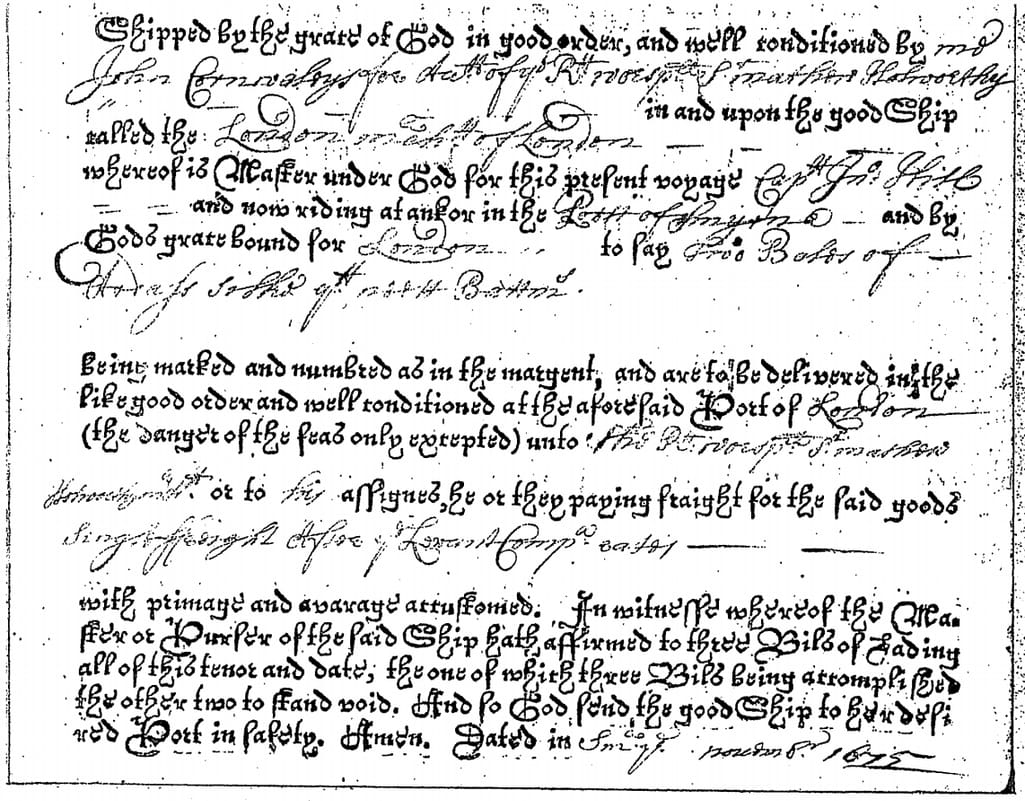
The scanned copy of the oldest bill of lading
Source: Australian and New Zealand Maritime Journal
The paper beginning “Shipped by the grace of God in good order and well conditioned by Mr John Cornvallis for Acctt of ys Rt worshipful Sir Matthew Holsworthy in and upon the good Ship called the London Merchant of London...” is not only a fascinating look into history, but an example of how standardized the document system had been back then. If you look at bills of lading that came after, in 1775 and 1821, you’ll notice that not much had changed for at least 150 years.
A similar devotion to tradition exists in the industry even today. Bills of lading - one of the key documents in international trade - are still created, sent, and stored in paper form. Even now, physical bills are sent via courier between carriers and exporters (often with freight forwarders in between), compromising on-time delivery. Documents supporting the integrity of 80 percent of all international trade are easily forged or lost. And the attempts to digitize them once and for all have been futile until now.
The solutions presenting completely paperless bills of lading started appearing in the late 90s, all aimed at eliminating unavoidable problems with physical documents. We will talk about these solutions in this article. But first, let’s cover the basics.
What is an electronic bill of lading?
Bill of lading (B/L or BoL) is one of the key documents in international trade. It performs three functions. It acts as:
- A receipt for shipment acknowledging that the cargo was loaded on a ship.
- Evidence of the contract between carrier and exporter.
- A document of title that means whoever possesses the original paper copy is the one legally entitled to deliver it to the destination.

An example of a physical bill of lading
While we’ve seen electronic contracts and receipts, the last function is way harder to replicate digitally. Why so?
The Hague-Visby Rules - standards for international carriage of goods by sea last updated in 1979 - don’t have clear instruction regarding whether an electronic document yields the same legal power as the paper one. The Hamburg and the Rotterdam rules appeared later to create a more modern framework. But while the former didn’t add any clarity, the latter has not come into effect at all lacking the needed number of ratifying countries. This means that for now, the outdated Hague-Visby rules dominate the market.
So, what’s the situation now?
Currently, the shipping industry has been using Electronic Data Interchange (EDI) systems. This 80s-era technology creates a direct connectivity channel between computers, allowing them to exchange documents in a strict format. We detailed how EDI works in a separate article, so have a look. EDI, which doesn’t eliminate physical documents, just provides a means to share them. So, it's just a half step ahead of paper BLs.
This is likely to change soon. Luca Castellani, secretary of the UNCITRAL Working Group IV of the United Nations Commission on International Trade Law shares that a recent Model Law is already improving the situation.
"In 2017 UNCITRAL has adopted the Model Law on Electronic Transferable Records whose goal is to replace those provisions and enable electronic bills of lading and other transferable documents (promissory notes, warehouse receipts, bills of exchange, cheques, etc.)
Moreover, the Explanatory Note to the MLETR makes specific reference on how to implement the Model Law using distributed ledgers. The MLETR has been adopted in Bahrain and is under consideration in Singapore and other counties."
Does it make modern solutions illegal?
No. Actually, none of the solutions we’ll cover today offer an electronic bill of lading, at least they’re not recognized as such by the law. These solutions are multilateral agreements in which all members adhere to a set of rules, basically treating the electronic bills as legal documents and agreeing to not challenge their validity. Neat, huh? Compared to EDI, these solutions, at last, provide the possibility of fully paperless trade.
But what is meant by “fully paperless trade”?
To understand the difference between EDI and current eBL implementations, the term “fully paperless trade” is used. Roughly, it means that the system should comply with the following conditions:
- Document creation should be completely electronic
- Approval of the documents should happen via digital channels
- Communication with banks should be completely electronic as well
- The process of transmitting documents through the end-to-end supply chain should happen digitally
However, fully paperless doesn’t mean seamless. If you’re not using any back office system or ERP, you’ll have only one of many supply chain processes digitized. That’s why some solutions provide APIs for your internal trade management systems. These pieces of code will allow you to pull data from eBL systems into scheduling, financial, and operational software, use it to automate routine tasks, save time and resources, and have control over the whole document lifecycle.
All the solutions we will discuss today adhere to this. Another important condition you should look for in a solution is an approval by the International Group of P&I Clubs. It's comprised of around 90 percent of the world's ocean-going tonnage covering the members’ third-party liabilities. Its approval signifies to industry players that the approved products have been checked for security and validity. As of now, the Clubs approve four eB/L providers, which we will talk about now.
How to implement an electronic bill of lading - comparing the main providers
The four eB/L systems approved by Clubs are Bolero, essDOCS, e-title, and edoxOnline. We will explain how they work, the integration type they provide, and what it takes to set them up.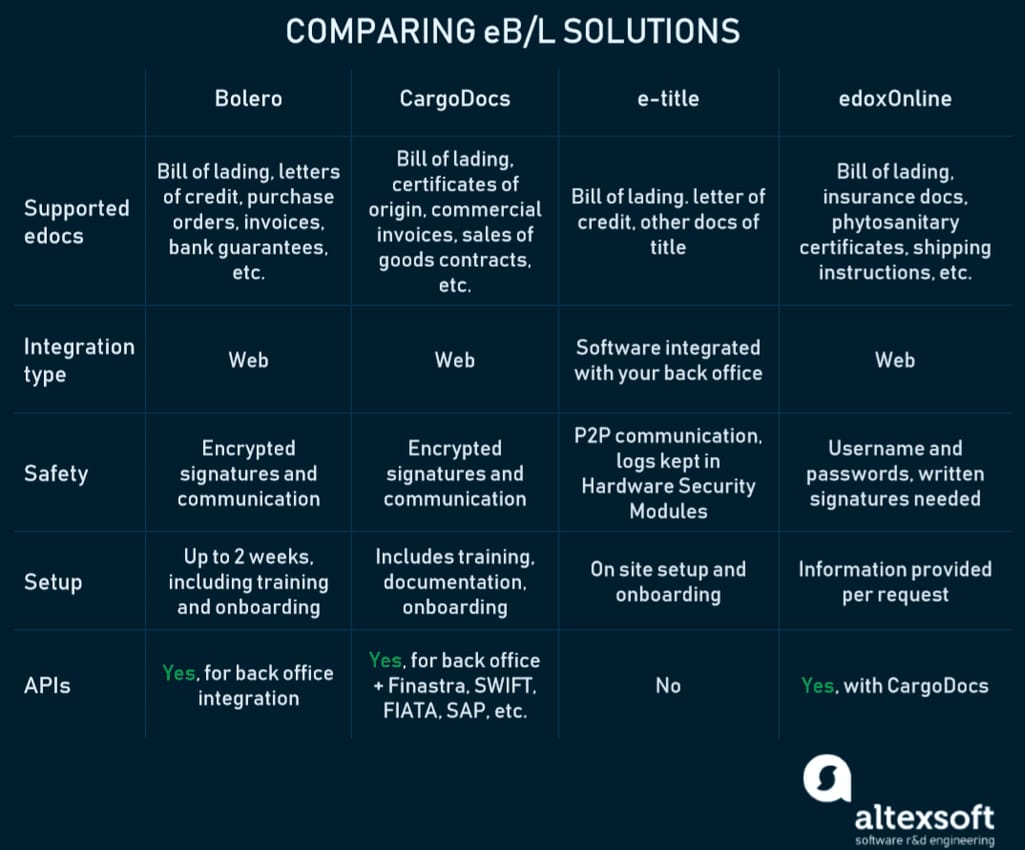
Electronic bill of lading solutions compared
Bolero: a decisive solution with the broadest industry coverage
The Bill Of Lading Electronic Registry Organization or Bolero has existed since the late 1990s and is the oldest existing eB/L system. Since then, it expanded to provide other supply chain documentation replacements, like purchase orders, invoices, letters of credit, insurance certificates, and more.
The two main features assuring the legality and safety of electronic docs in Bolero are the Rulebook - the legal framework guaranteeing that documents exchanged on the platform are valid - and encrypted signatures. The communication is also encrypted and Bolero is regularly audited to SSAE16 standards and its security management is certified to ISO 27001:2013.
How it works. An electronic bill of lading can be created only by a carrier or by their explicit authority the same way as a regular BL, adding cargo description, the port, the vessel, etc. You can create a document directly in the app or by scanning the paper one. The final document is then uploaded into Bolero with an attached Title Registry Instruction (TRI) - the record of the eBL that ensures that the data can’t be changed or copied. The eBL, including a TRI, is then electronically signed and sent to the shipper for review. When an eBL is surrendered, a carrier receives an email from Bolero, allowing them to release the cargo at the discharge port immediatyely upon receipt.
This transaction status on Bolero displays that the International-Bank-Co has surrendered the eBL to the carrier
Source: Bolero FAQs
Integration. Bolero is a cloud platform accessed by a web interface, but it also provides the ability to integrate with your internal back-office using gateway and mapping. That makes sense only if you’re processing a huge load of documents, so any information on how to do that is available per request.
Enrollment and setup. Being a closed system, Bolero accepts members manually, so you’ll need to register and wait for approval. Then, you will sign an agreement and receive training. Bolero estimates that the whole approval and setting up process will take two weeks. Using the system is free of charge for carriers, agents, forwarders, and operators. If you’re an exporter, you’ll have to request the pricing separately.
CargoDocs by essDOCS: rich for integrations
Founded several years after Bolero, essDOCS is now just as popular and widely used as its predecessor. Principally, these two systems are very similar: essDOCS also has a registry for storing eBLs, is web-based and centralized. Apart from BLs, essDOCS allows you to manage waybills, barge receipts, inspectors docs, cargo manifests, invoices, and more. CargoDocs is comprised of a two-hub solution - DocHub (for creating and approval) and DocEx (for document exchange).
essDOCS’s legal framework is called the Databridge Services & Users Agreement (DSUA). Security of transactions is ensured by ISO 27001 & ISO 27002 certificates and essDOCS is subject to annual audit by PriceWaterhouseCoopers.
How it works. The workflow of creating and managing documents is similar to the traditional one. You can also switch back to paper at any point if your partner is not using any eBL system. To make the change smooth, essDOCS provides over 50 templates to help you choose the one most similar to what you’ve been using before. You can also scan supporting paper documents, which will be converted into PDFs and signed to become electronic, but the same can’t be done with bills of lading as PDF is not the safest way of storing critical data.
Integration. Although CargoDocs works via a browser, you can use XML APIs to connect to your internal financial, operational or document creating systems. For connection with vessels, you can use secure email. essDOCS also supports out-of-the-box integration with Finastra, SWIFT (to present docs to a bank), FIATA, Conpend, FreightRoll, and more, including ERP integration with SAP per request.
Enrollment and setup. The essDOCS framework goes from adopting edocs to fully paperless trade. They recommend starting with DocHub to boost up to a quick ROI.
essDOCS’ suggested framework towards paperless trade
essDOCS provides delivery documentation and training, materials, and helps with setup and onboarding. It has three membership levels:
- standard (free, provided to all customers)
- strategic (standard + participation in workshops and events)
- observer (for non-users who want to attend events).
Pricing is available on request.
e-title: a P2P software accepting all formats
e-title was founded by ex-members of Bolero, but it works a bit differently from the previous two systems. This time, it’s not a closed centralized system, but a peer-to-peer network. We will explain how it works in a minute.
e-title was created to work in a hybrid environment, meaning that you can have a smooth workflow regardless of whether your partners use paper or electronic BLs. It accepts all formats of BLs - in EDI and XML, as PDF files, or an image - that it processes creating their electronic duplicates. Its legal framework called the ElectronicTitle User Agreement was written in accordance with UNCITRAL Model Law. It also supports other transport documents of title like warehouse receipts and bills of exchange.
How it works. e-title is a software connected to your back office or a trade documentation system. A carrier creates a bill of lading on paper or in their own document creation software and directs it to e-title. There, an eBL is created, signed, and registered in e-title’s Hardware Security Modules - powerful computers carrying logs of every transaction that can be pulled out to resolve disputes. The ready eBL is then sent back to a carrier’s back office, where it’s directed to the shipper’s system. On the shipper’s end, e-title verifies the signature and that the eBL hasn’t been changed.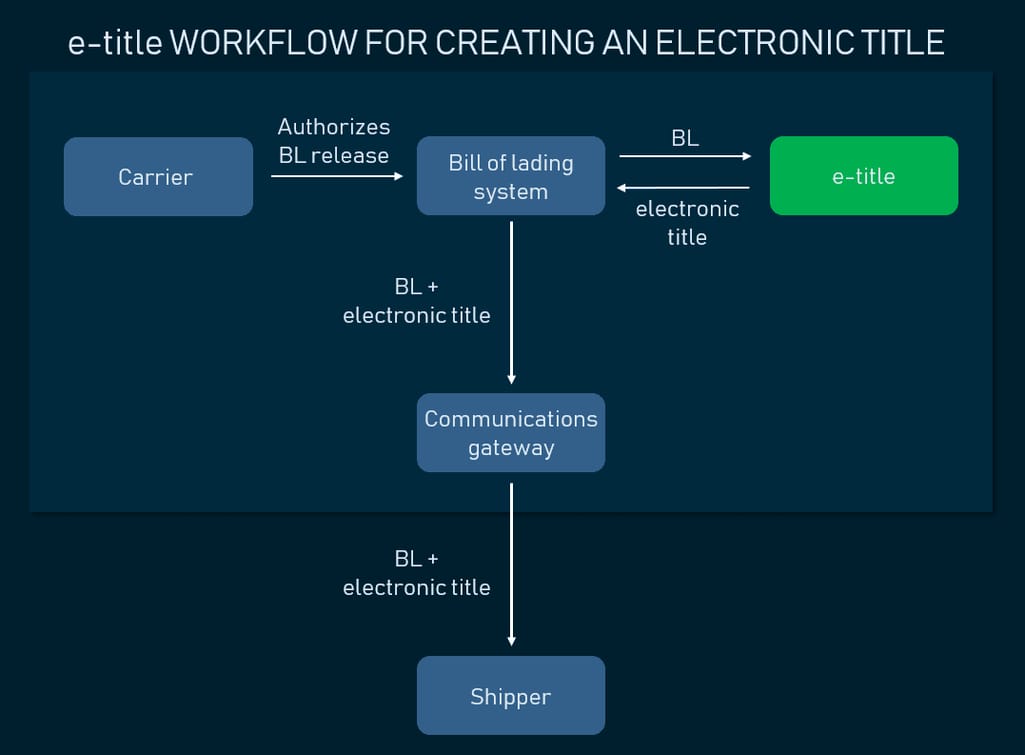
Creating an electronic title (carrier via own back-office application)
Integration. The e-title team travels to your office to help implement the solution and ensure a smooth transition. This is actually a part of their bigger mission to provide consulting services and transform the supply chain and logistics operations.
Enrollment and setup. Time estimates for onboarding and pricing should be negotiated directly.
edoxOnline by GlobalShare: a collaborative web portal
The last solution approved by the International Group of P&I Clubs is edoxOnline. Developed by the Argentinian transportation software provider GlobalShare, it allows you to automatically issue and manage eBLs in collaboration with all supply chain members. It was also the first eBL platform using the blockchain technology.
How it works. As the name suggests, edoxOnline is a web platform. The instructions for the document are created and entered from the destination point and then sent to the exporter’s origin country. There, an exporter coordinates with different members of the supply chain process such as maritime agents and shipowners who log into the system directly to add the corresponding information using two-factor authentication. The finished BL can then be saved as a PDF, printed and signed.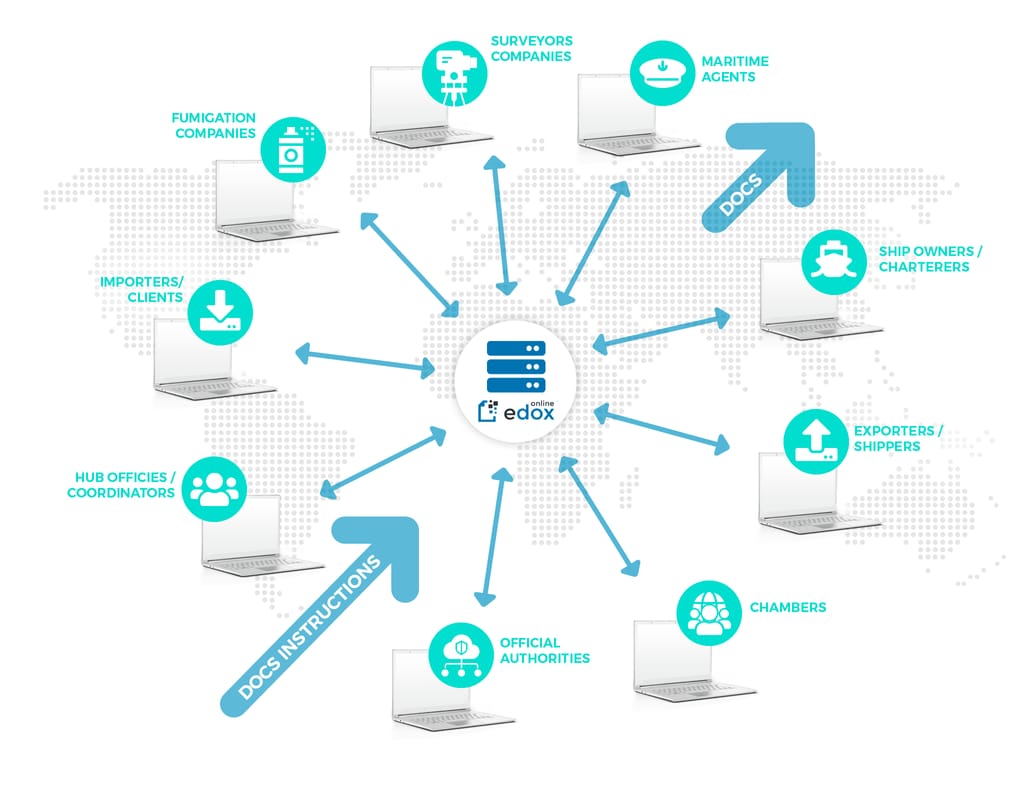
The collaborative nature of edoxOnline
Integration. The web platform is accessible to all members via a single page, but the system displays only the information needed for each member. edoxOnline has integrations with Bolero and CargoDocs via API.
Enrollment and setup. Contact the provider directly for the details.
The future is blockchain
In 2018, Maersk partnered with IBM to create TradeLens - the blockchain-powered platform for supply chain market players. Among its other features, the product presumably allows for exchanging the bill of lading data and validating B/L transactions. It uses an open REST API to connect to your back office. As of now, the initiative was joined by MSC, CMA-CGM, ZIM, Hapag-Lloyd, and more. It hasn’t been approved by the Clubs yet. Additionally, its functionality may be a bit robust and technically demanding for smaller carriers and exporters.
Another example of blockchain-supported doc exchange is fintech startup Wave, which released its paperless trade solution in 2018 as well.
Blockchain or distributed ledger technology can actually be the next step in ensuring document security. Unlike the current versions of eBLs, it’s an open, decentralized system, meaning that it doesn’t need a registry or approval. This will likely make the adoption of paperless trade more accessible to all participants.
Bolero and essDOCS are already working with Voltron to allow banks to access documents via a single integrated solution, and they’re hoping to open the opportunity to its network of exporters and shippers soon as well.
Still, all the solutions created today are just ways to overcome the real obstacle - the lack of regulation and clear instructions. The rules that haven’t been updated for decades need to keep up with the digital world, especially considering that the framework for change is already here.

Maryna is a passionate writer with a talent for simplifying complex topics for readers of all backgrounds. With 7 years of experience writing about travel technology, she is well-versed in the field. Outside of her professional writing, she enjoys reading, video games, and fashion.
Want to write an article for our blog? Read our requirements and guidelines to become a contributor.
